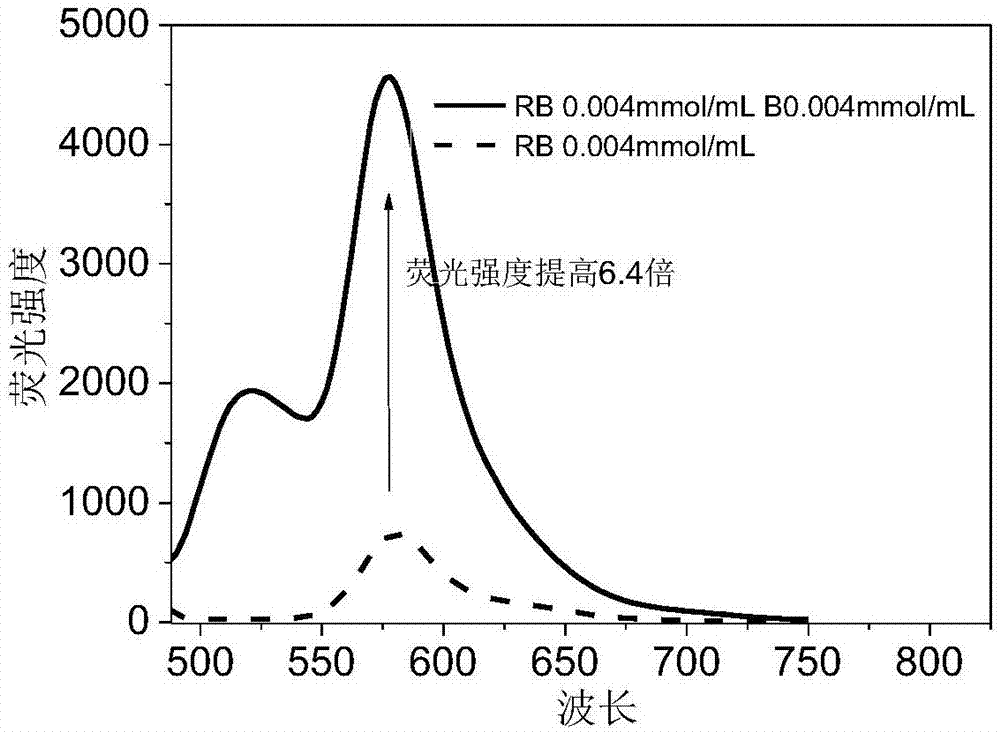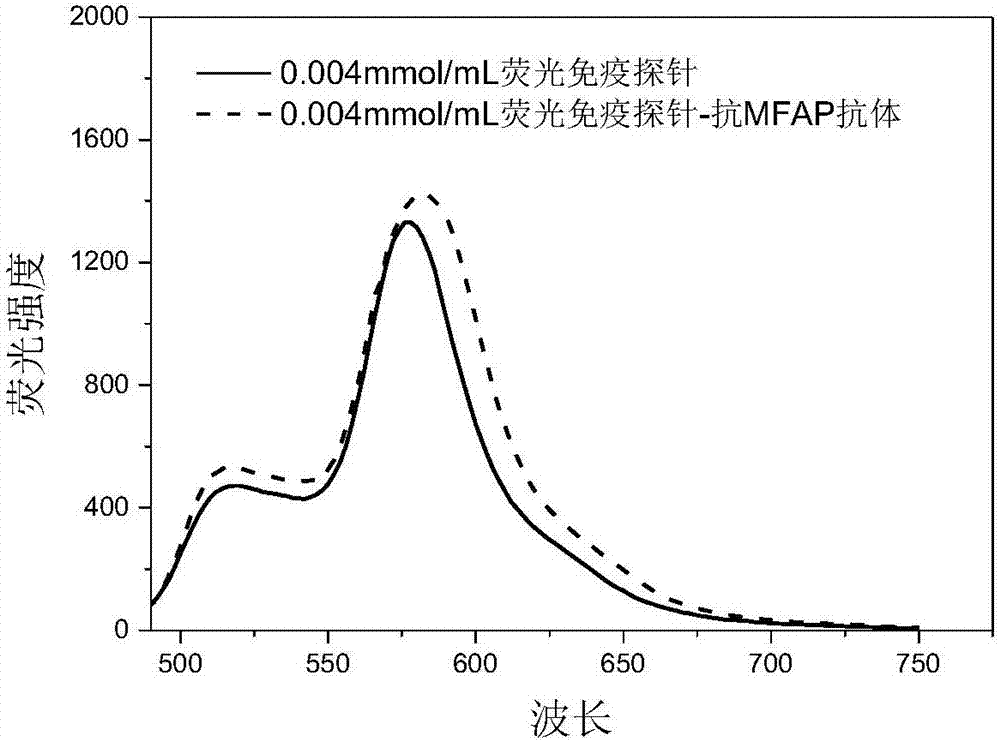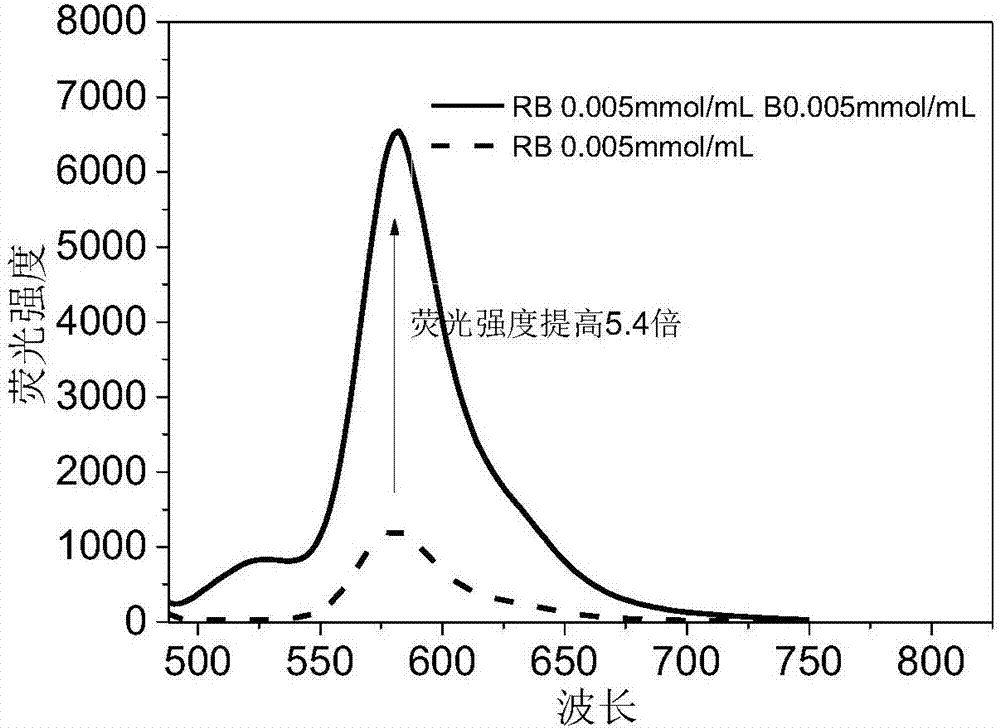Silica fluorescent immunolabeled probe based on fluorescence resonance energy transfer as well as preparation method and application of silica fluorescent immunolabelled probe
A fluorescence resonance energy and silicon dioxide technology, which is applied in the field of biological analysis and immune analysis, can solve the problems of slow carrier metabolism, toxic and side effects of organisms, etc.
- Summary
- Abstract
- Description
- Claims
- Application Information
AI Technical Summary
Problems solved by technology
Method used
Image
Examples
Embodiment 1
[0074] A method for preparing a silica fluorescent immunolabeling probe based on fluorescence resonance energy transfer, the method comprising the following steps:
[0075] 1) Dissolve 50 mg of cetyltrimethylammonium bromide CTAB in 50 mL of deionized water under magnetic stirring at 65 °C;
[0076] 2), then add 650μL ethylene glycol and 2.1mL ammonia water at 65°C;
[0077] 3) Add TEOS 200 μL within 5 minutes after adding ethylene glycol and ammonia water and react for 30 minutes;
[0078] 4), mix 0.5mL 0.004mmol / mL BODIPY solution and 0.5mL 0.004mmol / mL Rhodamine B solution, add the mixed solution of 1mL BODIPY and Rhodamine B to step 3), and then add trimethoxymethane Silane MTMS 30μL, react for 2h;
[0079] 5) Add 90 μL mL of 3-aminopropyltriethoxysilane APTES to continue the reaction for 1.5 hours;
[0080] After the reaction is completed, stir and cool to room temperature, centrifuge and wash 3 times, and freeze-dry to obtain RB-BODIPY-FRET silica nanoparticles, which...
Embodiment 2
[0091] An application of silica fluorescent immunolabeling probe-coupled antibody based on fluorescence resonance energy transfer, the specific method is:
[0092] 1. First prepare anti-MFAP highly specific polyclonal antibody:
[0093] 1-1. First immunization: mix the immunogen with Freund's complete adjuvant in equal volume ratio, emulsify with a syringe, and then immunize New Zealand white rabbits by subcutaneous injection on the back. Subcutaneously inject 10 points, the total dose is 1.0mg / kg / time. Booster immunization after three weeks;
[0094]1-2. Booster immunization: adopt the same back subcutaneous injection method and injection dose for injection immunization, and the different adjuvant used for booster immunization is Freund's incomplete adjuvant. After that, a booster immunization was carried out every two weeks, and the titer was measured by collecting blood from the edge of the rabbit's ear in the middle week. After the titer reached 1:64000, a booster immuni...
Embodiment 3
[0102] A method for preparing silica fluorescent immunolabeling probes based on fluorescence resonance energy transfer, comprising the following steps:
[0103] 1) Dissolve 50 mg of cetyltrimethylammonium bromide CTAB in 50 mL of deionized water at 65 °C;
[0104] 2), then add 650μL ethylene glycol and 2.1mL ammonia water at 65°C;
[0105] 3) Add TEOS 200 μL within 5 minutes after adding ethylene glycol and ammonia water and react for 30 minutes;
[0106] 4), mix 0.5mL 0.005mmol / mL BODIPY solution and 0.5mL 0.005mmol / mL Rhodamine B solution, add 1mL of the mixed solution of BODIPY and Rhodamine B to step 3), and then add trimethoxymethane Silane MTMS30μL, react for 2h;
[0107] 5) Add 90 μL mL of 3-aminopropyltriethoxysilane APTES to continue the reaction for 1.5 hours;
[0108] After the reaction is completed, stir and cool to room temperature, centrifuge and wash 3 times, and freeze-dry to obtain RB-BODIPY-FRET silica nanoparticles, which are silica fluorescent immunolabe...
PUM
 Login to View More
Login to View More Abstract
Description
Claims
Application Information
 Login to View More
Login to View More - R&D
- Intellectual Property
- Life Sciences
- Materials
- Tech Scout
- Unparalleled Data Quality
- Higher Quality Content
- 60% Fewer Hallucinations
Browse by: Latest US Patents, China's latest patents, Technical Efficacy Thesaurus, Application Domain, Technology Topic, Popular Technical Reports.
© 2025 PatSnap. All rights reserved.Legal|Privacy policy|Modern Slavery Act Transparency Statement|Sitemap|About US| Contact US: help@patsnap.com



